By Geoffrey Mandel
Sidebar notes by Martin Willey, 1999
Starlog #7, August 1977 (special supplement) and Japanese Starlog #3 (December 1978) fold-out page

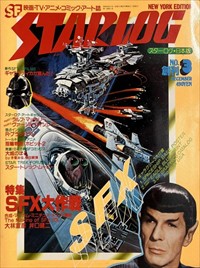 Blueprint sheet 1 | Blueprint sheet 2 | Blueprint sheet 3
Blueprint sheet 1 | Blueprint sheet 2 | Blueprint sheet 3
|
|
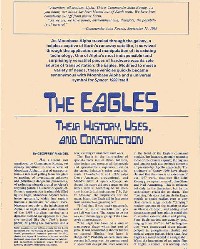 |
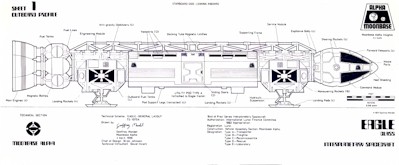 |
Geoffrey Mandel's blueprints are based on the second 44" Eagle model. |
| As Moonbase Alpha travelled through the galaxy, a helpless captive of Earth's runaway satellite, it survived through the application and manipulation of its existing technology. One of Alpha's most indispensable (and surprisingly versatile) pieces of hardware was its sole source of transportation: the Eagles. Modified to meet a variety of needs, these vehicles quickly became synonymous with Moonbase Alpha and a universal symbol for Space: 1999 itself.
An element not mentioned by Commander Koenig, yet equally important to the survival of Moonbase Alpha, is that of transportation--a means of getting from one place to another, of investigating unknown and potentially dangerous phenomena, of gathering minerals crucial to Alpha's recycling plants. This need for quick, efficient transportation is admirably filled by the Eagle, Moonbase Alpha's workhorse spacecraft, which has rapidly become a trademark for Space: 1999. Necessary not only to the inhabitants of Alpha, the Eagle is also a vital element of the 1999 storyline, serving as a dynamic method (as opposed to a passive method like Star Trek's transporter) of getting the characters into a new, exciting environment each week. |
|
| The Eagle is the innovation of special-effects master Brian Johnson, who designs and executes all the models and special-effects sequences used on the series. Johnson's other credits include Thunderbirds and UFO (also Gerry Anderson productions), and MGM's 2001: A Space Odyssey, although his name did not appear on the screen credits. According to an interview in the British publication T.V. SciFi Monthly, the inspiration for the squat, insect-like Eagle did in fact come from an insect- a grasshopper: "I find that if you make spacecraft, and so on, rather insect-like then you are half way there. That seems to be the way our technology is going. Take Concorde as an example. "The Eagle was based on a kind of grasshopper shape which just sort of grew. It was considerably shorter before we started filming, but later it elongated." |
Johnson did not work on UFO (he was working on 2001 at the time). |
Probably an even more important influence was the current trend in spacecraft design: the inset windows in the front of the Eagle's command module, for instance, strongly resemble those of the Gemini capsule; the engines and landing pads also embody elements of present-day Apollo spacecraft. The producers of Space: 1999 have always claimed that the show is an extension of our 1977 world, that men like John Koenig grew up in the era of John Glenn and Neil Armstrong. This is reflected not only by the characters, but by the technology available to them. The "cunning" devices that enable the Eagle models to retain realism even at very close camera range include "dirtying" random sections of the exterior to give an illusion of depth, and adding small pieces scavenged from plastic model kits to stimulate exterior detail and plating. Four Eagle models are actually used, ranging from 5 1/2" to 44" in length-they were constructed from plaster, perspex (a plexiglas-like plastic) and molded copper piping. More than four Eagles are rarely needed in a single shot. When the impression of an entire fleet of Eagles is desired, it is accomplished either by quick, successive camera angles of Eagles taking off and flying by, or by an optical superimposition of several shots showing Eagles of diminishing size. The largest Eagle, costing some $3,000 to build, is equipped with hydraulic landing pads and freon gas propulsion to "raise dust" upon take-off.

|
There were actually 7 models: one 5 1/2", one 11", two 22", three 44". The landing pads are sprung, not hydraulic. |
The Eagle: An Official DossierThe Eagle is one of several classes of interplanetary spacecraft (others include the Hawk warships, Swift support vessels, and deep-space probes), originally authorized by the International Lunar Finance Commission and constructed by the Engineering and Technics section of Moonbase Alpha using materials and components either shipped from Earth or manufactured on the Moon. Completely modular, the crafts are divided into three basic sections: the command module, the service pod, and the superstructure--containing the landing gear, main fuel tanks and boosters. Eagles, standard reconnaissance craft for all extralunar activity, are powered by four nuclear fusion rockets and carry fuel reserves for 48 hours of flight. Artificial gravity force fields built into the Eagle enable it to accelerate up to 15% of the speed of light, giving it a maximum range (with extra fuel reserves) of several light-days. The Eagle also has the capability to enter the atmosphere of a normal- gravity planet, land (using its chemically-fueled landing rockets), and return to Alpha. Although the Eagle was not designed for use as a military vessel, it has as standard equipment a laser gun and an arsenal of space-to-space missiles. |
|
| Eagles are piloted by an astronaut with official designation of Eagle Pilot and a rank of no less than Captain. The pilot receives his orders directly from Mission Control, and employs both the onboard and Alpha computer systems for guidance, astronavigation, and interpretation of sensor data. The right seat in the Eagle cockpit is usually occupied by a copilot, although the Eagle can normally be handled by a single operator. In an emergency, when both pilots are incapacitated, an Eagle may be operated from a slave-station in Command Center. | Alan Carter is a Captain in the first series- and he is head of the Reconnaissance Section (he is a Lieutenant in Year 2). |
Types Of Eagles Used By Moonbase Alpha:Transporter EaglesTransporter Eagles, fitted with the standard passenger pod, can normally accommodate eight passengers in addition to the pilot and co-pilot. Under emergency conditions (such as total evacuation of Moonbase), they can carry up to twelve passengers and additional water and provisions for extended habitation. Transporters are used for missions on the lunar surface, in lunar orbit, and in interstellar space in the general vicinity of Moonbase; or on routine planetary landings when no hostile elements are anticipated and the contact team deems special laboratory or environmental equipment unnecessary. Reconnaissance EaglesAlthough the recon pods look similar to the transporter pods on the outside, they are equipped with various types of sensory devices for exploratory missions. The recon pods also contain a computer that can either be tied into Alpha's master computer or work self-sufficiently. Rescue EaglesRescue Eagles are Transporters that have been fitted with a special passenger pod, identified by bold red stripes on the exterior. These are adapted for field diagnosis and treatment of injury or disease that may be encountered on a planet's surface or in deep space. Manned by medical personnel, Rescue Eagles are equipped with mobile beds, patient-monitor units, and facilities for field surgery. Freighter EaglesThe cargo pod, identical to the passenger pod in configuration, is used for transporting supplies and equipment to exploration teams on a planet's surface, and for the return of native elements essential to Alpha's environmental and reprocessing systems. Freighters can also be used for refuelling Eagles as space-borne tankers, transporting additional fuel to Eagles with insufficient reserves to return to Alpha. |
 |
|
The Eagle can also accommodate one of several specialty modules such as the winch platform used in "Breakaway" to disperse the nuclear waste cannisters. For Year Two, the Eagle had some interesting additions: a strap-on booster back, used in "The Metamorph," which increases the range and power of the Eagle; and the laboratory pod (first shown in "All That Glisters"), a modified version of the passenger pod equipped to serve as a remote laboratory. Uses of this pod include the location and refinement of crude minerals on a planet's surface, eliminating the need to transport bulky raw ores back to Alpha. This pod also acts as a base for a planetary-contact-and-survey team: it can carry food and water and recycle air to support the team for several weeks, providing ample time for exploration before the Moon's trajectory moves it out of range. |
The laboratory pod is actually first seen in Year 1 (Guardian Of Piri). |
| Eagles are serviced in the mammoth hangar complexes directly beneath the four main launch pads. A crew of Eagle engineers is responsible for repairing or replacing damaged components, and maintaining the Eagles in flight-ready condition. Alpha supports a fleet of twelve Transporter Eagles, twenty-six Recon Freighters, and two Rescue Eagles on 24-hour alert status. | There are actually 5 launch pads, plus additional launch pads in outlying research stations. |
| In the event of Operation Exodus -immediate and complete evacuation of Moonbase Alpha on the personal order of Moonbase Commander- all available Eagles are employed to transport colonists and supplies from Alpha to a habitable planetary environment. Until such time, the Eagle remains the workhorse of Moonbase Alpha -as indispensable to the 311 men and women of Alpha as the Conestoga wagon was to the settlers of America's Western frontier. | |
| Mandel has to stretch the interior considerably, but this is not a bad compromise between the exterior design and interior set. The best version is undoubtedly Roberto Baldassari's "Ultimate Eagle Blueprints" and poster cutaway. |
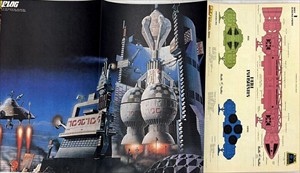
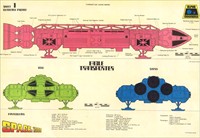
The Japanese Starlog reprint in issue 3 was part of a 3-page fold-out, most of which was a futuristic city painting. Only the side, front and back elevations were included, each in different colours.
See also:Text and blueprints copyright Geoffrey Mandel; page and notes copyright Martin Willey